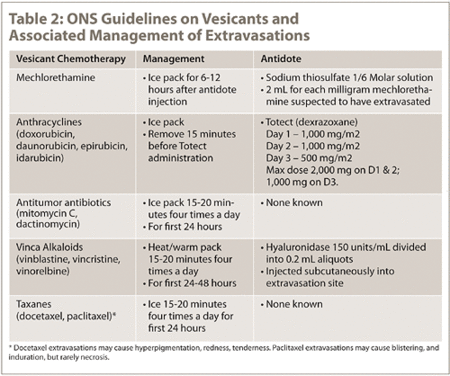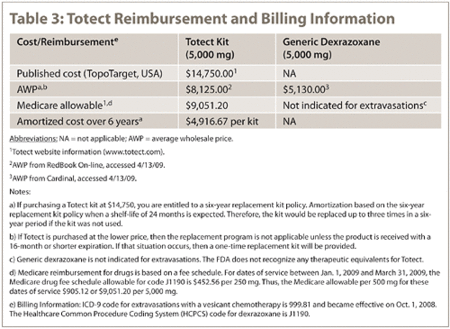Oncology Nursing Society releases updated guidelines on management of extravasations
During the past several years, the Oncology Nursing Society developed and maintained Chemotherapy and Biotherapy Guidelines and Recommendations for Practice, providing a unique and vital source of authoritative information for practicing oncology clinicians specifically related to complications of anticancer drug administration. In March, the third edition of this guideline was published, including updated information on management of extravasations.
This acute event, when associated with vesicant administration, can result in serious long-term clinical consequences, up to and including damage to tendons, nerves and joints, functional and sensory impairment of the affected area, and even the loss of a limb. Prevention and appropriate patient selection are key factors in reducing the risks associated with vesicant administration. Risk factors for extravasations have been identified and utilized when making individual decisions regarding the use of peripheral vs. central venous access devices (see table 1). Although the use of central venous access devices may limit the risk of extravasations occurring, extravasations from these devices do occur. Risk factors for this happening are also listed in table 1.

Signs and symptoms of vesicant extravasation include swelling, redness, stinging, burning or pain, loss of blood return, IV flow rate that slows or stops, and leaking around the IV catheter or port needle. Sites of extravasation are not always painful and patients may not notify the administering clinician of any problems, potentially delaying interventions that could limit the volume extravasated and/or prevent serious complications. Detailed patient education is paramount to preventing and limiting the detrimental outcomes seen with vesicant extravasations. Flare reactions or vein irritation may mimic extravasations but are unique with peripheral administration. Extravasations are generally considered relatively uncommon (0.01% to 6%), but also may be under-reported given the delayed nature of some local reactions to extravasated vesicants (eg, vinorelbine) and the varied symptoms that can occur.
Vesicant-specific management: anthracyclines
Different vesicant agents are associated with differing clinical effects, treatments and/or antidotes (see table 2). Historically, anthracyclines have been perhaps the most commonly written about and studied vesicants. Methods for prevention and management have been quite diverse throughout the years and several antidotes have been described with variable success. Topical cooling has traditionally been the only uniformly agreed upon management technique adopted by most institutions around the world. Other historic antidotes have never been studied in a formal prospective manner in biopsy-proven extravasations. Their use was traditionally based on anecdotal information, case reports or small case series.

Based on available evidence, the only antidote supported in the current edition of the ONS guidelines is Totect. In September 2007, dexrazoxane (Totect, TopoTarget USA) was approved by the FDA for the treatment of extravasation resulting from IV anthracycline therapy. In the December 2007 issue of HemOnc Today, the clinical data with Totect were reviewed, and some of the controversies surrounding the product launch for this agent were discussed.
Although the clinical data related to this agent have not changed since our original report, many changes have occurred with respect to the pricing, reimbursement and availability of the drug.
To review briefly, Totect was approved based on results from two open-label, single-arm multicenter clinical trials conducted in Europe, including patients with biopsy-proven anthracycline extravasations. The primary objective of the studies was to determine the rates of surgical intervention following anthracycline extravasation when Totect was administered. Standard-of-care management of extravasations at the institutions participating in these studies included immediate surgical intervention and local measures such as topical cooling. Totect was administered at a dose of 1,000 mg/m2 IV over one to two hours daily for two days, then 500 mg/m2 IV on the third day following extravasation. The first dose of Totect was required to be given within six hours of the known extravasation and was administered in the opposite limb of the extravasation. When the two trials were combined, 80 patients were enrolled and 54 patients were assessable for efficacy. Only one patient (1.9%) required surgical resection. At these doses, Totect can be quite myelosuppressive and particular attention should be paid to monitoring for infections.
Because this agent is the first antidote for extravasations to have substantial data to support its use, there has been a great deal of debate and dismay among health care providers related to the cost of Totect.
It is supplied as an emergency treatment kit that contains 10 vials each of dexrazoxane 500 mg and diluent (the maximum dose used in the clinical trials). The kits have a shelf life of 24 months but may rarely if ever be used due to the infrequent nature of this complication. TopoTarget USA, the manufacturer of the drug, created a replacement program for the kit that guarantees replacement of the product if not used within six years from the date of initial purchase. Institutions may now purchase the drug at a reduced cost without the replacement program. These measures have made it more affordable for facilities of all sizes to stock the kits and have them readily available for patients who may need them.
Smaller institutions with budget constraints have explored creative ways to access the drug in a timely manner without bearing the entire cost of the agent. In some smaller cities, health care organizations have discussed sharing a kit. However, issues related to cost sharing and transportation of an agent that will rarely if ever be used can be problematic and limit the success of such a plan. Some institutions have decided to stock only generic dexrazoxane.
This decision may be problematic if third-party payers limit payments for extravasations to only the brand Totect. However, both generic and brand dexrazoxane have the same billing codes (see table 3). Since the FDA has explicitly stated that there are no generic equivalents for Totect, it may be difficult to argue that generic dexrazoxane is appropriate. This point is very controversial and fraught with a variety of legal and financial issues that are well beyond the scope of this article.

Other chemotherapy
Mechlorethamine extravasation is rarely encountered in contemporary oncology practice given that the clinical utility of this chemotherapy has been usurped by other safer, more effective agents. Nonetheless, sodium thiosulfate is a well-established antidote for these extravasations, but that is based on anecdotal reports and case series that predate the modern era of central venous access devices. Extravasation of vinca alkaloids is managed very differently than other chemotherapy agents. The use of topical cooling actually exacerbates ulceration, and warm compresses should be utilized when these agents are extravasated. Hyaluronidase has also been described as an effective antidote for extravasations of vinca alkaloids. Multiple brands and formulations of hyaluronidase are now available and the subcutaneous administration is unique (see table 2). The evidence supporting the use of hyaluronidase is also limited to anecdotal reports and case series, but has been well-accepted practice in many countries around the world.
As is apparent by the nature of the evidence, the use of antidotes for treatment of vesicant extravasations is shaky at best with the exception of the Totect data. The ethical and logistical constraints of studying this clinical event has led to necessary recommendations based on clinical experience and consensus gathering from experienced practitioners in conjunction with a small amount of published data. Incorporation of the ONS guidelines into any practice setting should be examined within the constraints of the individual institution. Examination and questioning of the data supporting these guidelines is highly recommended. Only with scrutiny and further examination can clinicians seek to improve upon what is considered as current best practices.
Chad Barnett, PharmD, BCOP, is a Clinical Pharmacy Specialist at The University of Texas M.D. Anderson Cancer Center.
Laura Boehnke Michaud, PharmD, BCOP, is Manager of Clinical Pharmacology Services at The University of Texas M.D. Anderson Cancer Center.
For more information:
- Dexrazoxane (Totect) product information; TopoTarget USA, October 2007.
- Dexrazoxane (Totect) website information (www.totect.com).
- Immediate complications of cytotoxic therapy. In: Polovich M, Whitford JM, MiKaela Olsen, eds. Chemotherapy and Biotherapy Guidelines and Recommendations for Practice (Third Edition). Oncology Nursing Society Publications; 2009.
- Kane RC. Oncologist. 2008;13:445-450.
- Schulmeister L. Oncologist. 2008;13:284-288.




